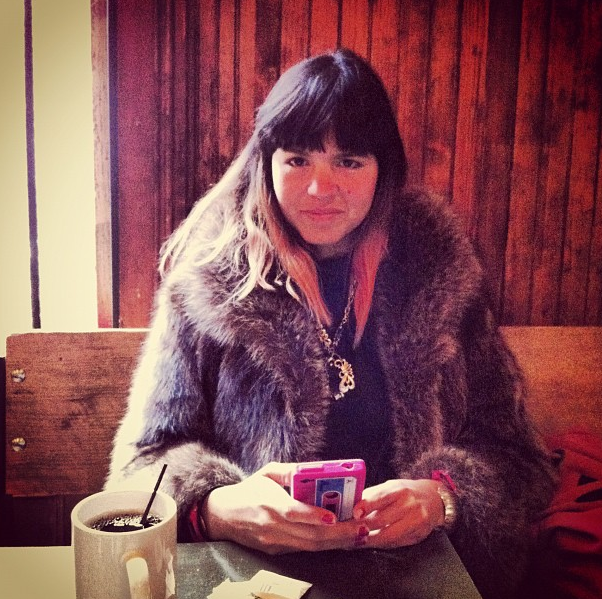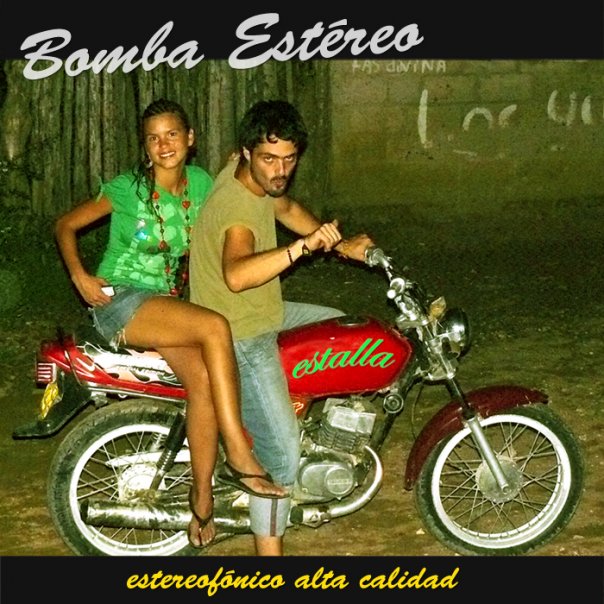How Bomba Estereo Blew Up and is Keeping it Elegant
The rise of the Colombian band, in three acts (and albums).
Nov. 21, 2012— -- In early September, Simón Mejía and Liliana Saumet, one of half the electro-tropical quartet Bomba Estereo, stood on a stage in Bogotá and accepted a framed gold disc for the band's 2008 sophomore album, Blow Up!, which had sold over 10,000 records in Colombia.
The timing of the recognition was ideal from publicity standpoint since the quartet was launching the break-through record's follow-up, Elegancia Tropical. But its symbolism was also apparent. If Blow Up! was Bomba Estereo's introduction of their Colombia to the world, Elegancia synthesizes all of the sounds, ideas, and lessons from their global gigging back to Colombia.
On this album, the band draws from Afro-pop, dubstep, freestyle, psychedelia, cumbia, and champeta, among others. Two years in the making, Elegancia finds members singer-MC Liliana (aka Li), bassist/producer Mejía, percussionist Kike Egullorra, and guitarist Julián Salazar globally-informed and a bit more serious.
"Elegancia Tropical is a new phase for Bomba Estereo," Li, 33, explained in Spanish, over coffee in Williamsburg recently. "It's a bit more elegant because it's more mature and tranquil; less jovial than before and more introspective." Li Saumet in Williamsburg, Brooklyn, November 2012.
Li Saumet in Williamsburg, Brooklyn, November 2012.
When the Bogotá crew first emerged at stateside music showcases in 2009, the world's burgeoning interest in digital cumbia and other electronic-folkloric fusions had created a receptive audience for their kinetic, party-starting blend of cumbia, champeta, dub, and psychedelia.
Bomba's most popular (and iconic) song was a radio-friendly cumbia called "Fuego," in which its singer-MC Li introduced herself and her outfit with a flow that recalled Spanish rapper Mala Rodriguez and legendary Colombian singer Joe Arroyo but with a tropical swagger and asymmetrical haircut that was all her own.
What's In Your Suitcase? Li Saumet of Bomba Estereo Shows Us Everything!
The group, like its fiery hit, was raw and fresher than anything by any of Colombia's established musical ambassadors (Shakira, Juanes, Fonseca, Carlos Vives). Bomba struck the right balance of folk and electronic music to defy "Latin" or "world music" labeling. The band would spend the next four years playing hundreds of dates and festivals like Coachella, Vive Latino, Roskilde and more.
But to fully understand where they've gone on this new record, it's worthwhile to look at where they come from. Because Bomba Estereo's origin story is emblematic of a new generation of Colombian musicians Artists who've grown up in the shadows of a violent past, honed and incubated their art in local scenes and harnessed the DIY power of the Internet as well as the country's increasing stability to help them gain international exposure and success on their terms.
Vol. 1: Early days 
Simón came up in Bogotá's fertile underground scene around 2003 at a time when music-makers like Aterciopelados' Hector Buitrago (through his electronic label Entrecasa), Sidestepper, and, Simón's earlier group, AM 770 were beginning to fuse traditional Colombian rhythms with electronic music. Young people from all parts of the diverse country were living and studying in the capital and bringing the sounds and cultural elements of their lands into the city's cultural milieu.
"It was a very nascent style," said Simón, 35, in Spanish, during a recent phone interview from Bogotá. "Today it's a very established sound and popular but at that time, it was totally new."
He founded Bomba Estereo in 2005 as a sound system that featured a series of guest DJs, visual artists, and musicians. Among them was Liliana, who collaborated on the track "Huepajé" from the act's 2006 debut album, Vol. 1.
Li had left her native coastal city Santa Marta to study photography and eventually found her way to the capital in her 20s. But her first exposure to hip-hop was at age 11, when some New York-born Colombian friends introduced her to 2 Live Crew and other hip-hop of the era.
"I remember one of the songs went 'F**ck Martinez, F**ck F**ck Martinez,'" she recalled. "But I was super-influenced by that and started to turning songs, even love songs, into raps."Another of her major early influences is Joe Arroyo, who she grew up listening to and whose image she recently tattooed onto her arm. Nicolás Cano Vallejo, editor of Colombian music mag Shock, said the first Bomba effort was very electronic, experimental, and almost as if Simón was searching for the right formula.
"But in 'Huepajé,' you feel a song," he explained on Skype, in Spanish. "There's a chorus and Li's lyrics are felt as well as that super indigenous cadence that she gives Bomba Estereo's music."
Simón and Li found their musical chemistry too good to pass up and she joined the group.
Blow Up!: Hitting It Big "Liliana and I practically made Blow Up! all by ourselves at home," explained Simón. "Then when we went to record it in the studio, Kike was already playing drums and Julián was our sound engineer so he also recorded guitars and then became part of the group."Bomba's ascent from alt-underground outfit to international band began shortly after. It was the result of a combination of savvy decisions, good fortune, and nonstop touring.
"Liliana and I practically made Blow Up! all by ourselves at home," explained Simón. "Then when we went to record it in the studio, Kike was already playing drums and Julián was our sound engineer so he also recorded guitars and then became part of the group."Bomba's ascent from alt-underground outfit to international band began shortly after. It was the result of a combination of savvy decisions, good fortune, and nonstop touring.
In 2009, the group hit Austin's annual music showcase SXSW and began generating stateside buzz.
"There was this desire for the existence of other music that wasn't salsa, merengue, or tropical," Liliana explained. "Something that we Latinos would identify with but that gringos would also get."
Blow Up! came out on the reputable U.S. Latin-alt label Nacional Records, whose roster includes alt-rock icon Manu Chao and pioneering Colombian outfit Aterciopelados. Tomás Cookman's muscular imprint insured the quartet one of the best introductions to the U.S. market available to a Latin-alt act.
Bomba played a string of sets at that summer's Latin Alternative Conference (LAMC) in New York and became its breakout act. A fact that was confirmed when they were tapped as the last-minute fill-in opening act for Puerto Rican alt-rap band Calle 13 in one of the LAMC's marquee concerts at Central Park Summerstage.
The fortuitous gig proved to be a pivotal, "door opening" moment, Simón said. "We've practically been on tour with that album since then going from festival and festival." Bomba Estereo in Buenos Aires in 2011.
Bomba Estereo in Buenos Aires in 2011.
For the next three years, they hit the festival circuit. Hard. Bomba has played Coachella, Bonaroo, Vive Latino (Mexico), Lollapalooza Chile, Rock Al Parque (Colombia), Roskilde (Denmark), Paleo Festival (Switzerland), Primavera Fauna Festival (Chile), Sonar (Spain), and Expo Shanghai.
"Word spread--to festival bookers, through the internet and MySpace, by giving away music, especially to deejays, who would play it at their parties," he continued.
Meanwhile at home in Colombia, Bomba Estereo's success had the ripple effect of piquing national and international interest in the country's musical scene.
"Bomba Estereo were important protagonists in Colombia's musical boom," said Nicolás."There were others before them but Bomba emerged at the perfect place and time to inspire a generation--not only of musicians--but of journalists, parties, festivals, bars..."
But it's not without its pitfalls. Nicolás acknowledged that Bomba—and other emerging Colombian acts like them (ChocQuibTown, Systema Solar, Frente Cumbiero, Ondatropica, and Monsieur Periné)--have all had to leave and play abroad in order to become more successful at home.
Elegancia Tropical: Where They've Been & Where They're Going
In January 2010, Bomba Estereo retreated to a beach house near the coastal city of Barranquilla to begin work on its third effort. But touring demands halted its progress for a year. The band ultimately decided to work on it on the road, including during their six-week stateside tour in 2011.
"I took advantage of those moments of not-doing-anything in the van to program the whole album and that's how it was completed," said Simón. "We finished the vocals and everything else at the end of 2011."
Bomba's songwriting process begins with Simón, who produces the songs' electronic bases. "Musically, I always try to start with folkloric rhythms," said Simón. "That is, take elements from folkloric musical patterns, try and translate them to beats and place melodies on top of them."
He then shares the results with the other members, who add lyrics (Liliana), guitar and synth parts (Julián, who is 27), and percussion (Kike, who is 36). The band then convenes, assembles the songs, adds them to their live repertoire and then finally records them.
Simon maintained that Bomba didn't go into the studio with a preconceived concept or theme for Elegancia Tropical.
"It's an album that summarizes these years on tour and what it's generated in us musically and as people," said Simón. "Because these have been years where we've been uprooted in one way or another and one searches for a way to strengthen one's self."Li echoed Simon's sentiment.
"I use the lyrics as a diary of what happens to me" she said. "The last four years are in those lyrics." Nicolás sees Elegancia as a transitional album that's experimenting but also offering answers.
"It offers a hypothesis of what Colombian music will sound like in the future," Nicolás mused.

One constant on this new album is Bomba's commitment to remaining independent and DIY. The band opted to the release the album on indie labels rather than sign to a major. Elegancia came out on Polen Records in Colombia and on the imprint Terrícolas Imbéciles, in Mexico. The UK-based Soundway Records will be in charge of the physical U.K. and U.S. releases early next year.
In the meantime, the band is back on the road. After already playing Mexico in October, Bomba Estereo wrapped up the Colombian leg of the Elegancia Tropical tour this past weekend. They continue on to Chile, Uruguay and Argentina. Li says the group looks forward to playing in the States next spring.
Four years after first blowing up with Bomba, Liliana now grasps the responsibility of being an artist. "We have an important message to share," she said close to the end of our interview.
"This is about helping. A lot of people don't realize that and think success is money and fame. In reality that's what confuses. Success, in reality, is the ability to help others. Because that's why you sing, that's why you write, that's why you paint: to save lives. To save others."